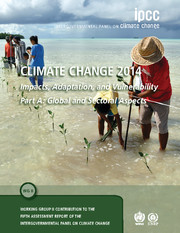 Climate Change 2014 – Impacts, Adaptation and Vulnerability: Part A: Global and Sectoral Aspects
Climate Change 2014 – Impacts, Adaptation and Vulnerability: Part A: Global and Sectoral Aspects Book contents
- Frontmatter
- Contents
- Foreword, Preface, and Dedication
- Summary for Policymakers
- Technical Summary
- Cross-Chapter Boxes
- Chapters 1-20
- Chapter 1 Point of Departure
- Chapter 2 Foundations for Decision Making
- Chapter 3 Freshwater Resources
- Chapter 4 Terrestrial and Inland Water Systems
- Chapter 5 Coastal Systems and Low-Lying Areas
- Chapter 6 Ocean Systems
- Chapter 7 Food Security and Food Production Systems
- Chapter 8 Urban Areas
- Chapter 9 Rural Areas
- Chapter 10 Key Economic Sectors and Services
- Chapter 11 Human Health: Impacts, Adaptation, and Co-Benefits
- Chapter 12 Human Security
- Chapter 13 Livelihoods and Poverty
- Chapter 14 Adaptation Needs and Options
- Chapter 15 Adaptation Planning and Implementation
- Chapter 16 Adaptation Opportunities, Constraints, and Limits
- Chapter 17 Economics of Adaptation
- Chapter 18 Detection and Attribution of Observed Impacts
- Chapter 19 Emergent Risks and Key Vulnerabilities
Chapter 12 - Human Security
Published online by Cambridge University Press: 05 January 2015
- Frontmatter
- Contents
- Foreword, Preface, and Dedication
- Summary for Policymakers
- Technical Summary
- Cross-Chapter Boxes
- Chapters 1-20
- Chapter 1 Point of Departure
- Chapter 2 Foundations for Decision Making
- Chapter 3 Freshwater Resources
- Chapter 4 Terrestrial and Inland Water Systems
- Chapter 5 Coastal Systems and Low-Lying Areas
- Chapter 6 Ocean Systems
- Chapter 7 Food Security and Food Production Systems
- Chapter 8 Urban Areas
- Chapter 9 Rural Areas
- Chapter 10 Key Economic Sectors and Services
- Chapter 11 Human Health: Impacts, Adaptation, and Co-Benefits
- Chapter 12 Human Security
- Chapter 13 Livelihoods and Poverty
- Chapter 14 Adaptation Needs and Options
- Chapter 15 Adaptation Planning and Implementation
- Chapter 16 Adaptation Opportunities, Constraints, and Limits
- Chapter 17 Economics of Adaptation
- Chapter 18 Detection and Attribution of Observed Impacts
- Chapter 19 Emergent Risks and Key Vulnerabilities
Summary
12.1. Definition and Scope of Human Security
There are many definitions of human security, which vary according to discipline. This chapter defines human security, in the context of climate change, as a condition that exists when the vital core of human lives is protected, and when people have the freedom and capacity to live with dignity. In this assessment, the vital core of human lives includes the universal and culturally specific, material and non-material elements necessary for people to act on behalf of their interests. Many phenomena influence human security, notably the operation of markets, the state, and civil society. Poverty, discrimination of many kinds, and extreme natural and technological disasters undermine human security.
The concept of human security has been informed and debated by many disciplines and multiple lines of evidence, by studies that use diverse methods (Paris, 2001; Alkire, 2003; Owen, 2004; Gasper, 2005; Hoogensen and Stuvøy, 2006; Mahoney and Pinedo, 2007; Brauch et al., 2009; Inglehart and Norris, 2012). The concept was developed in parallel by UN institutions, and by scholars and advocates in every region of the world (UNDP, 1994; Commission on Human Security, 2003; Najam, 2003; Kaldor, 2007; Black and Swatuk, 2009; Chourou, 2009; Othman, 2009; Poku and Sandkjaer, 2009; Rojas, 2009; Sabur, 2009; Wun Gaeo, 2009).
This chapter assesses the risks climate change poses to individuals and communities, including threats to livelihoods, culture, and political stability. Chapters in Working Group II (WGII) in the Fourth Assessment Report (AR4) identified the risk climate change poses to livelihoods, cultures, and indigenous peoples globally (Chapters 5, 7, 9 10, 16, and 17) and that migration and violent conflicts increase vulnerability to climate change (Chapter 19), as well as highlighting that migration plays a role in adaptation. But this chapter is the first systematic assessment across the dimensions of human security.
- Type
- Chapter
- Information
- Climate Change 2014 – Impacts, Adaptation and Vulnerability: Part A: Global and Sectoral AspectsWorking Group II Contribution to the IPCC Fifth Assessment Report, pp. 755 - 792Publisher: Cambridge University PressPrint publication year: 2014
- 10
- Cited by
